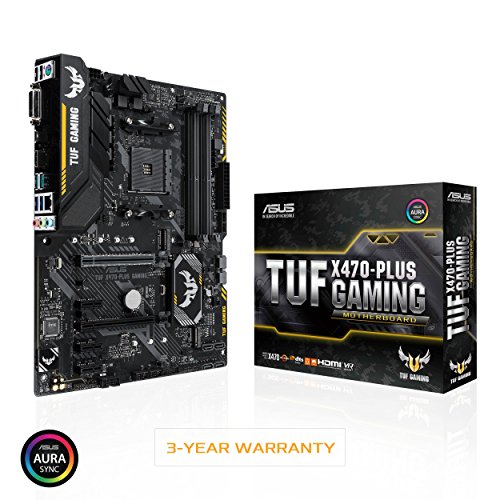Asus TUF X470-Plus Gaming Review

Asus TUF X470-Plus Gaming Review – There are plenty of premium X470 boards around already but, as Asus and Gigabyte have shown this month. The TUF X470-Plus Gaming is part of Asus’ aim to reinvent the TUF brand, which used to include the likes of the Sabertooth and Gryphon series, but now focuses on the lower end of the market, albeit still with its own aesthetic flare.
Table of Contents
The TUF X470-Plus Gaming feels noticeably lighter than the ROG Crosshair VI Hero, which might partly be down to the small cut-out in its PCB. This notch takes a leaf out of the ROG Maximus IX Apex’s design book, but it looks snazzy, as does the subtle yellow lighting, and black and silver colour scheme. Asus also includes an I/O shroud that does a fantastic job of hiding those unsightly ports.
The price tag affects several areas, though, such as the CPU power circuitry, which has just six phases and two rather small heatsinks, both of which are trumped by the similarly priced Gigabyte X470 Aorus Ultra Gaming. It also lacks an additional CPU power connector, has no M.2 heatsinks, lacks a USB 3.1 Type-C header and its Type-C port is limited to USB 3 speeds too.
The TUF is also the only board on test to drop from Realtek’s ALC 1220 audio codec to the less capable ALC 887, which sees the number of audio outputs drop to three on the rear I/O panel too. Meanwhile, the lack of an M.2 heatsink saw our Samsung 960 Evo SSD run 13″C warmer than the next best-performing board on test. On the plus side, while the second M.2 slot is limited to two PCI-E lanes, both M.2 slots can cater for SATA M.2 SSDs.
At stock speed, the TUF X470-Plus Gaming performed similarly to the rest of the field and even managed the second highest system score on test at 204,411. The lack of an SSD heatsink didn’t seem to hinder the M.2 speed tests either, with read and write speeds of 3,377MB/sec and 1,871MB/sec respectively.
Being an Asus board, you also get all the usual extensive software perks and an excellent EFI, although one snag is that vcore adjustment is limited to offset figures up to 0.5V – you couldn’t input a specific voltage, which made tweaking tricky.
The TUF is the only board on test to drop the audio codec to the less capable ALC 88
We managed to hit a top clock speed of 4.25 GHz with our Ryzen 7 2700X CPU using a vcore of 1.425V, which matched some of the other boards on test, although a couple of boards hit higher frequencies using the same voltage. However, the system drew a massive 298W when overclocked, compared to just 268W for the ROG Crosshair VII Hero.
That said, the Gigabyte X470 Aorus Ultra Gaming drew more power still. Finally, the audio performance was, not surprisingly, poor compared with the rest of the field, with a dynamic range of 91.6dBA compared to 110dBA for the Gigabyte X470 Aorus Ultra Gaming.
Asus TUF X470-Plus Gaming Review: Conclusion
In many ways the TUF X470- Plus Gaming is a solid offering, with a great EFI and software package. However, it costs around £ too much given that Gigabyte’s X470 Aorus Ultra Gaming costs less money, while still offering a stronger set of features and better audio performance. If you’re after an X470 board with a tight budget, the Gigabyte is a better option.
PERFORMANCE 30/35
FEATURES 22/35
VALUE 26/30
Asus TUF X470-Plus Gaming Review: VERDICT
Cheap but not particularly cheerful in one or two areas, while the competition costs less and offers more.
Asus TUF X470-Plus Gaming Review: SPECIFICATIONS
Chipset AMD X470
CPU socket AMD Socket AM4
Memory support 4 slots: max 64GB DDR4 (up to 3200MHz)
Expansion slots One 16x PCI-E 3, one 16x PCI-E 2, three 1x PCI-E 2 Sound 8-channel Realtek ALC 887 Networking Realtek Gigabit LAN Overclocking No base clock adjustment; max CPU multiplier 64x: max voltages: CPU +0.5V, RAM 1.8 V
Ports 6 x SATA 6Gbps (X470), 2x M.2, 1 x HDMI, 1 x USB 3.1 Type-A, 1 x USB 3.1 Gen 2 Type-C, 2 x USB 3, 2 x USB 2,1 x LAN, 3 x surround audio out
Dimensions (mm) 305 x 244





